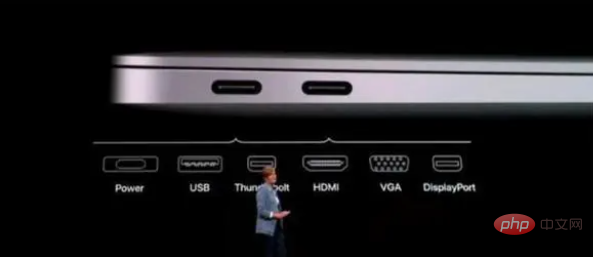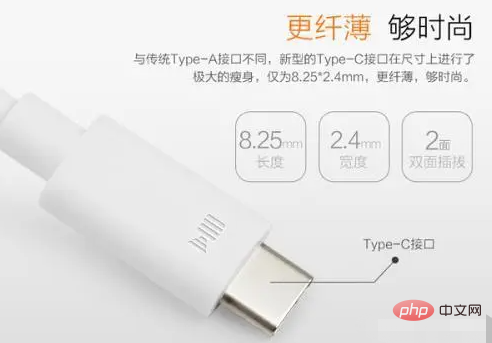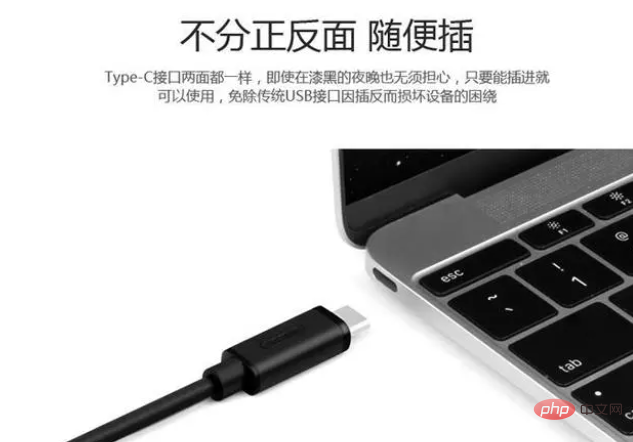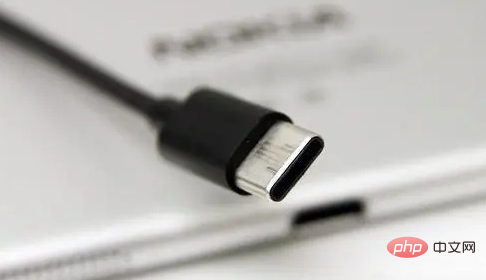
Typec data cable refers to a data cable that uses USB Type-C as the interface. Type-C is a brand new USB interface form. From the appearance and function point of view, its characteristic is that there is no need to distinguish between the front and back, both sides can be plugged in, and it is a symmetrical oblate shape. Type-C adopts the USB3.1 standard. It is a new interface developed by the USB standardization organization to solve the long-term disadvantages of USB interfaces such as inconsistent physical interface specifications and the only one-way transmission of power. It integrates charging, display, data transmission and other functions. All in one.

The operating environment of this tutorial: HarmonyOS 2 system, HONOR V30 mobile phone.
Type-C data cable refers to a data cable that uses USB Type-C as the interface.
type-c interface introduction
type-c is a new USB interface form, commonly used in today’s mainstream Android Mobile phones, computers and other electronic products. From the appearance and function point of view, its characteristic is that there is no need to distinguish between the front and back, both sides can be inserted, and it is a symmetrical oblate shape.
Its core features can be summarized in three words: "fast, strong and small". Compared with previous generations of traditional interfaces, Type-C can be more advanced and simultaneously support charging, data transmission, image transmission and other functions, truly realizing the powerful use of "one mouth for multiple purposes".
Type-C is a hardware interface specification for the Universal Serial Bus (USB); it was born with the latest USB 3.1 standard. Released by the USB-IF organization in August 2014, it is a brand-new interface developed by the USB standardization organization to solve the long-term disadvantages of USB interfaces such as inconsistent physical interface specifications and the only one-way transmission of power. It integrates charging, display, and data transmission. functions in one.
In 2014, the Type-C interface standard was officially born. Subsequently, Apple completely canceled the power interface, USB interface, DP interface, HDMI interface, and VGA interface on the Macbook laptop released in 2015, and integrated them into a Type-C interface to realize all the above functions. As a result, the Type-C interface is completely popular.

#The biggest feature of the Type-C interface is that it supports insertion in two directions, front and back, which officially solves the worldwide problem of "USB can never be plugged in correctly". It can be plugged in at will. .
The Type-C interface mainly has the following advantages:
First, the interface is smaller. Compared with the past USB Type-A interface, Type-C greatly reduces the interface area and is more suitable for application in various slim devices;

Second, support "positive and negative blind insertion". Since the front and back designs of the Type-C interface are exactly the same, the "front and back blind insertion" function is perfectly realized, and users do not need to worry about "the USB is always not plugged in correctly";
Third, Supports fast charging and two-way charging. The Type-C interface supports the USB PD protocol, a power transfer protocol, which can achieve higher voltage and current. It can be expanded to an output voltage of 20V and a maximum output current of 5A, which is a maximum output power of 100W, which greatly improves the charging speed.

In addition, it can freely change the direction of power transmission, charging itself and charging external devices in reverse. Based on this principle, we can use a USB Type C to C cable to achieve series charging.
Fourth, it supports the USB3.1 standard, and the maximum data transmission speed can reach 10Gbit/s. However, not all Type-C interfaces support the USB 3.1 standard. It may also only support USB2.0, USB3.0 and other transmission protocols. This is something you need to pay special attention to.
Fifth, extremely rich functional scalability. As mentioned before, the Type-C interface integrates charging, data transmission, image transmission and other functions. In other words, using only one Type-C interface cable solves the problem of different interface cables such as HDMI, DVI, and VGA.

In summary, Type-C not only has extremely advanced functions, but also has smaller size, higher compatibility and performance. Therefore, it has been widely used in computers and smart phones. It has gradually become a mainstream unified interface recognized by the public in various electronic products such as mobile phones, tablets, peripheral accessories, and storage hard drives.
What’s more worth mentioning is that after the emergence of the latest USB 3.1 transmission standard, the Type-C interface has become its only recommended interface. In the Thunderbolt 3 interface launched through in-depth cooperation between Apple and Intel, the previous mini DP was also replaced by USB Type-C. These changes have undoubtedly promoted the vision of the Type-C interface to achieve "great unification" in the future.
As of the date of publication, the USB family has released the USB3.2 standard , and unified the new naming, all USB will now be called USB 3.2, so how to distinguish the speed? Listed below are the before and after name changes
|
##Before the name change
|
Bandwidth
|
##After name change
|
|---|---|---|
| ##USB 3.0
| ## 5Gbps
|
|
|
|
|
|
|
20Gbps
|
##USB 3.2 Gen 2× 2 |
##After USB3.1 | , and the original
in 2017USB3.2 (20Gbps )reached the peak of brain-burning after its launch. Its full name isUSB3.2 Gen2x2, and at this time,USB3.1 and USB3.0were replaced by RenamedUSB3.2 Gen2(10Gbps)
USB3.2 Gen1(5Gbps).All USB protocols:For more related knowledge, please visit the
column!
The above is the detailed content of What is typec data cable. For more information, please follow other related articles on the PHP Chinese website!
 What is the difference between USB-C and TYPE-C
What is the difference between USB-C and TYPE-C How to solve http error 503
How to solve http error 503 How to make a call without showing your number
How to make a call without showing your number The role of the caption attribute
The role of the caption attribute How to trade VV coins
How to trade VV coins Ripple trading platform
Ripple trading platform How to recover data after formatting
How to recover data after formatting The difference between lightweight application servers and cloud servers
The difference between lightweight application servers and cloud servers